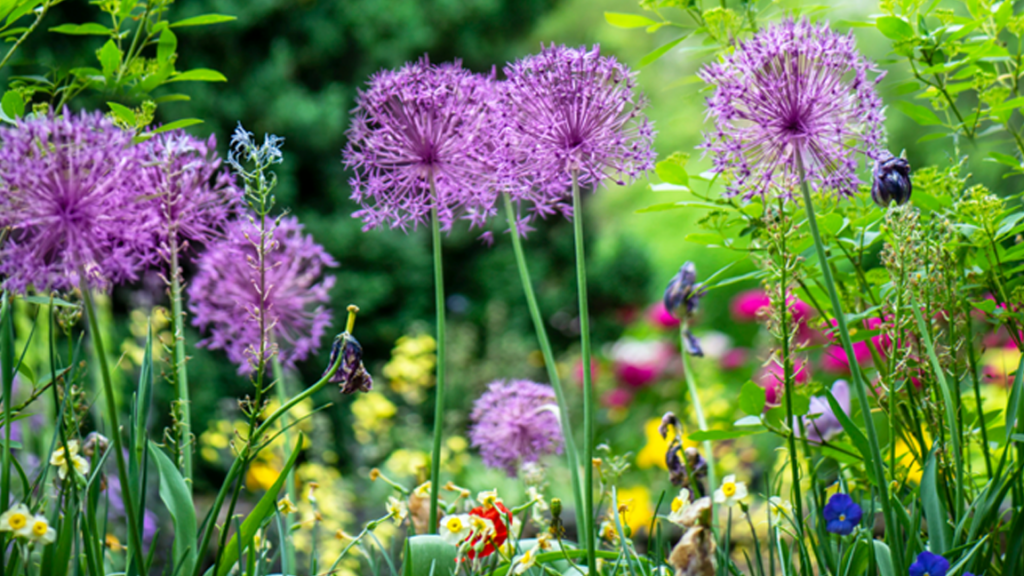
As a color specialist, I often get asked about color palettes in areas beyond the home’s interior or exterior. For instance, I will sometimes get clients asking about landscaping arrangements and garden color selections.
While I’m not a professional landscape architect, I do fancy myself a competent gardener with a modestly green thumb, so I feel that I can offer garden color palette suggestions without being out of my element.
What’s especially wonderful about garden colors and working with nature’s color palettes is that there are always new opportunities, new color arrangements, giving you ways of bringing in new forms of color inspiration to your home’s outdoor areas! Whether you garden to harvest fresh vegetables or garden to create beautiful floral arrangements that change with each season or garden to create a colorful oasis outside your home, gardening is a therapeutic hobby to have in your life.
In this article, I’m going to talk about some of the garden color concepts that you should keep in mind next time you’re at the nursery!
When you’re thinking about updating your garden’s scheme and layout, be careful to make observations about how the area is affected by sunlight. Plants and their colors will have a different presence depending on how much sunlight they get during the day. Observing how much of your garden is in full sunlight vs. how much time it’s in the shade throughout the day will help you make better plant and color choices.
Areas of your garden(s) that get lots of shade will benefit greatly from using lightly colored plants and flowers. Pastel pinks, purples, yellows, and blue work especially well in the shade, as they almost glow with color in dark areas but do not create an overtly excited mood.
For areas of your garden(s) that get lots of sun, plants and flowers with deeper, richer, and heavily saturated colors work best. Lightly colored plants will get washed out and disappear into the background when exposed to too much bright sun; however, deeper, darker, and more rich colors like deep blue, royal oranges, and rich-vibrant reds will absorb sunlight better and present themselves to the fullest in the brightest of circumstances.
Some of the most basic color principles will factor into your garden color choices and arrangements. Harmonious colors, the colors that sit next to each other on the color wheel (color spectrum), tend to work very well in gardens to create harmony and calming color palettes. An example of these harmonious colors working together in a garden would be purple periwinkles set next to blue hydrangeas or orchids. A classic example is red and yellow tulips, a match made in heaven!
Choose plants with lots of variety and color choices to accomplish this harmony as long as the colors sit next to each other on the color wheel, or they are in color families that share a common color. For example, purple allium can go along with blue and purple irises or pinkish purple liatris. They share colors in the purple family, making them great choices that will pack your garden full of harmonious colors!
Complementary colors are the opposite of harmonious colors. Complementary colors sit across from each other on the color wheel. These colors create contrast, excitement, and dynamic presence when placed together in a garden.
By arranging parts of your garden with complementary colors, you’ll create something more dramatic and attention-grabbing as opposed to harmonious colors. An example of these complementary colors in a garden would be a saturated blue iris next to brilliant yellow daisies! Or light pink begonias next to lime green spider mums! These color combinations are very exciting and eye-catching for anyone enjoying your garden experience.
When selecting plants for your garden, you should consider the current colors that the plants have and what color changes they will make as the seasons go by.
It’s wonderful to get even a few beautiful weeks of color out of some plants, let alone seasons. Still, there are some garden arrangements that you can assemble that will change from spring through fall and cascade your outdoor garden areas with a variety of colors!
For example, some plants produce dramatic colors in the summer and then completely pivot to new colors for the winter. The viburnum is a shrub that has gorgeous pink berries in the latter days of summer, and then in the fall, the berries turn deep blue, and the foliage turns a deep vibrant red, talk about your 2-for-1 deal! There are many different plants and flowers that perform similar seasonal changes that will keep your garden looking lively for most of the year!
I also go to great lengths to choose plants for my garden, knowing what colors will bloom in what order! For example, I planted astilbe with beautiful plumes of dense pink flowers. Once they pass, the liatris go on to bloom in a bright purple. While the liatris are fading, my Black-eyed susans are coming into their own with a brilliant yellow and black flower! It takes a little time to plan it all out.
I made a chart for myself so that I can see what is going to bloom when. It takes a little time to get this right, but lay it all out on paper, and it will be easier than you think! I do know from experience it is well worth the time spend to get it right!
As a color expert, I’m always looking to hear what other color enthusiasts have for suggestions. Have you planted any blooming flowers or shrubs that have taken your garden to an elevated level of color-inspiration? Please share your garden stories; I’d love to hear them!